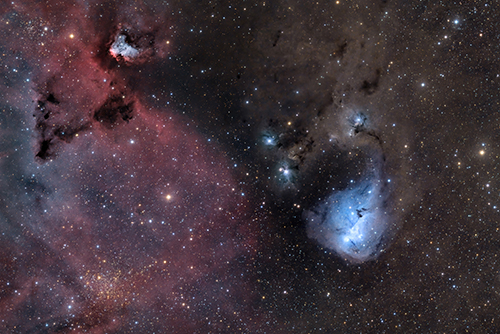by Groovynight » Thu Jan 25, 2024 4:11 pm
IC 2169 / IC447 in Monoceros

(Thumb only)
>>>High Resolution:
https://astrophoto-hannover.de/download ... s_Horn.jpg
In the constellation Monoceros, west of the Cone Nebula and the Christmas Tree Cluster IC 2169 / IC447 can be found, a true gem of a reflection nebula. Next to IC447, the smaller reflection nebulae IC 446, NGC 2245 & 2247 can also be seen. The entire region belongs to the "Monoceros R1 Complex" (Mon R1), an active star-forming region located approximately 2,500 light-years away. On the left side of the image, the star cluster NGC 2259 and some LDNs and LBNs are also present.
The image is based on 12.5 hours of RGB. To better balance the colors in the image, I enriched the area of the gas nebula with a bit of Ha and OIII signal. In doing so, I was able to use data from my capture of the Christmas Tree Cluster from last year, which fortunately overlapped exactly in this area.
Celestron RASA 8
Celestron Motorfocuser
EQ6-R Pro
ZWO ASI 2600 MC Pro (Gain 100, Offset 18, -10°)
RGB: 731 x 60" (12h 11')
TS 2600 MP Mono (Gain 100, Offset 200, -10°)
Ha (Baader f2 3.5nm): 200 × 60″ (3h 20′)
OIII (Baader f2 4 nm): 130 × 120″ (4h 20′)
Total: 19h 51‘
Darks, Flats, Darkflats, Dithering
N.I.N.A., Guiding: ZWO ASI 120MM & PHD2
Astropixelprocessor, Photoshop, Pixinsight
Date: January 8 & 9, 2024, January 19, 2023, January 17, 2022
Location: Hannover, Germany (Bortle 5-6)
Contact:
Website:
www.astrophoto-hannover.de
Instagram: @astrophoto_hannover
Astrobin:
https://www.astrobin.com/users/Groovynight/
E-Mail:
info@astrophoto-hannover.de
[b]IC 2169 / IC447 in Monoceros[/b]
[img]https://astrophoto-hannover.de/downloads/IC447_by_Markus_Horn_thumb.jpg[/img]
(Thumb only)
>>>High Resolution: https://astrophoto-hannover.de/downloads/IC447_by_Markus_Horn.jpg
In the constellation Monoceros, west of the Cone Nebula and the Christmas Tree Cluster IC 2169 / IC447 can be found, a true gem of a reflection nebula. Next to IC447, the smaller reflection nebulae IC 446, NGC 2245 & 2247 can also be seen. The entire region belongs to the "Monoceros R1 Complex" (Mon R1), an active star-forming region located approximately 2,500 light-years away. On the left side of the image, the star cluster NGC 2259 and some LDNs and LBNs are also present.
The image is based on 12.5 hours of RGB. To better balance the colors in the image, I enriched the area of the gas nebula with a bit of Ha and OIII signal. In doing so, I was able to use data from my capture of the Christmas Tree Cluster from last year, which fortunately overlapped exactly in this area.
Celestron RASA 8
Celestron Motorfocuser
EQ6-R Pro
ZWO ASI 2600 MC Pro (Gain 100, Offset 18, -10°)
RGB: 731 x 60" (12h 11')
TS 2600 MP Mono (Gain 100, Offset 200, -10°)
Ha (Baader f2 3.5nm): 200 × 60″ (3h 20′)
OIII (Baader f2 4 nm): 130 × 120″ (4h 20′)
Total: 19h 51‘
Darks, Flats, Darkflats, Dithering
N.I.N.A., Guiding: ZWO ASI 120MM & PHD2
Astropixelprocessor, Photoshop, Pixinsight
Date: January 8 & 9, 2024, January 19, 2023, January 17, 2022
Location: Hannover, Germany (Bortle 5-6)
Contact:
Website: www.astrophoto-hannover.de
Instagram: @astrophoto_hannover
Astrobin: https://www.astrobin.com/users/Groovynight/
E-Mail: info@astrophoto-hannover.de